Panmure Golf Club, Scotand
by Gordon A. Jones

The Clubhouse at Panmure “ one of the best in Scotland.
Established in 1845, Panmure Golf Club is one of the oldest golf clubs in the world. The club originally played over the Monifieth links, but when the course became overcrowded they considered moving to the Carnoustie links, before deciding to build their own private course between the two at the end of the 19th century. The clubhouse was to be built at a railway stop beside the current sixth green, but on hearing that this stop was to be removed by the railway company they were forced to build the clubhouse nearer to the Barry railway station (at the west end of Carnoustie’s large practice ground). As a result, the first and last three holes play over relatively flat land, to get to the linksland on which the course was to be built. The result is that the course has three distinct sections “ the flat semi-parkland links of holes one, two, three, sixteen, seventeen and eighteen across what used to be farmland, the heathland style four, five, six, seven, fourteen and fifteen that play through small pine forests, and the classic linksland holes eight, nine, ten, eleven, twelve and thirteen. The outward half is the shorter of the two, but is invariably played into the wind. The course contains a lot of bunkers that are largely out of play for better players, but other than a few at the start of some fairways (first and sixteenth) that were filled in recently, most are left as they frustrate the higher handicapper and are a traditional part of the course!
The club (also referred to as “Barry” as the course is technically the Barry links) is always used as a local final qualifying venue when the Open is held at Carnoustie, and was also used for the 1990 Open at St Andrews. In the most recent Open qualifying three players qualified, all scoring -5 for their two-round total. In contrast all of the other three Open final qualifying courses had qualifying scores of between -8 and -10. This is fairly typical and was the case in 1999 also.
Ben Hogan famously practiced on the seventeenth fairway prior to his Open victory in 1953, as both he and the club were very private, and this allowed him peace from the press. The club invited him to use the clubhouse, but he declined on the grounds that the club pro wasn’t allowed in and he didn’t want to cause offence. He also asked that the seventeenth green be cut lower so that is better simulated conditions at Carnoustie, so the head greenkeeper handed him a mower! To his credit he not only cut the green, but he cleaned the mower before returning it! His legacy at Panmure is a nasty bunker on the sixth hole. When playing a round with the secretary he commented that it was one of the best holes he had ever played, but that it could be improved with a pot bunker at the front right of the already tough to hit green. One was promptly built!
The clubhouse at Panmure is one of the best in Scotland. Modeled both architecturally and spiritually on the clubhouse of the Royal Calcutta Golf Club, it is a reminder of the trading links between the Tay and Hooghly rivers, and looks as if it has been there forever. From the changing rooms to the casual bar (the green room) to the gentleman’s club atmosphere of the formal lounge and the dining room, the clubhouse has an old world feel to it that perfectly captures the traditions of the past 150+ years. Here are a couple of photos of the formal lounge:
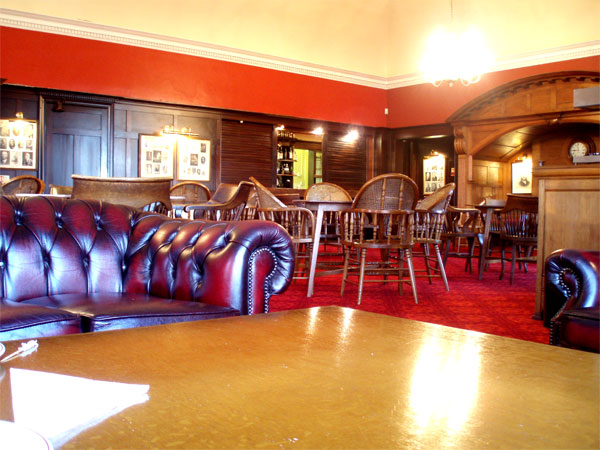
The clubhouse bar above and the changing room below.

First hole “ par 4 “ 302 yards – Maule:The first hole is a short par four. The tee has been altered in recent years and extended back slightly, but it is still drivable. There is a possibility that the green may one day be moved back and right to extend the hole, with the second tee moving over to the left of the greenkeeper’s shed.
Second hole “ par 5 “ 488 yards – Lochside:This par five is another must birdie hole. As with the first (and nine other holes at Panmure) OB is to the right, but shouldn’t come into play. At a professional’s driving distance there is an awkward ridge in the fairway and deep bunkers left and right. If these are avoided the shot to the green is fairly straightforward and the green relatively flat. This is the end of Panmure’s easy start.
Three hole “ par 4 “ 404 yards “ Pines

Tee shot on the par four third.
The third tee shot is the only one on the course where trees come into play, although for the pros this would only be the case if into a very strong wind. You play to a dogleg right fairway that, once over the horizon from the tee, slopes away from you and narrows with very thick rough through the fairway.
Most players lay up in the wide bit of the fairway down the left-middle, but this creates problems on the second short as you have a middle to long iron that must carry a central bunker and run up to the green. However, the landing area over the bunker is domed, and anything that isn’t right down the centre will kick off into greenside bunkers left and right.
Fourth hole “ par 4 “ 352 yards “ Ravensby
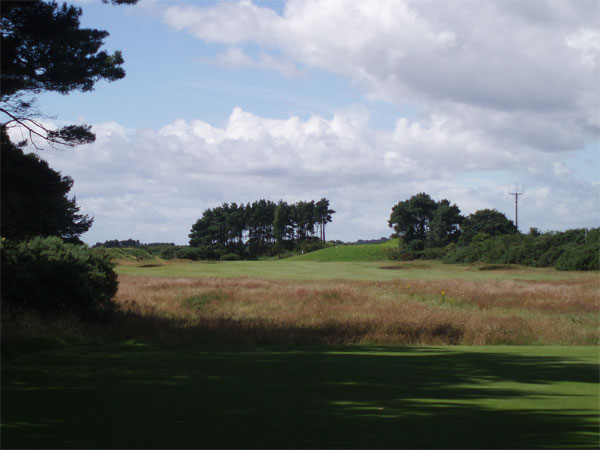
Tee shot on the par four fourth.
The fourth tee shot is straight away ¦ bunkers left and right. The fairway is constantly rippling, making a flat lie unlikely. There is a large valley short of the green, and the green has a large gentle slope up at the front left, and a sharp slope at the front right, making a peninsula of raised green at the front right that creates a nasty pin position. The safe play is to the back of the green, but with the pin near the front this creates a fast downhill putt to a pin with a huge drop just behind it.
Fifth hole “ par 3 “ 144 yards – Punchbowl
The first par three is a fairly short hole, but as is typical at Panmure the green is quite small. Anything on the green will roll towards the centre of the green, but anything that misses will roll away, towards bushes or bunkers, leaving a tricky second shot. The tee is very wide on this hole, allowing for a number of different angles into the green depending on how happy the greenkeeper was that morning.
Sixth hole “ par 4 “ 414 yards “ Hogan:
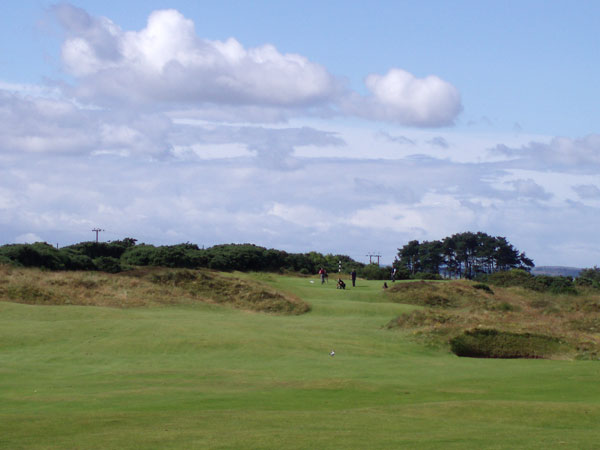
Approach to the par four sixth (looking back from the seventh fairway).
The hole that Ben Hogan said should have a greenside bunker, only for one to quickly appear. You drive over a heath clad hill to a fairway hidden from view. If you don’t quite catch your drive it can get caught in a valley in the fairway, leaving you 190 yards uphill to the green. If your drive makes it past this valley you can expect an approach shot of about 150 yards uphill to a small green with a sharp twenty foot drop off to the right, a eight foot drop into bushes behind, bushes and the OB directly left of the hole and a long gradual drop off the front for any shot that doesn’t quite make it up. Hogan’s bunker is front right, and if you play to the front left (the safest place) there is a mound lurking to potentially leave you with a horrible pitch over it. The hardest hole on the course, it is normally played into the wind.
Seventh hole “ par 4 “ 449 yards “ Eastwards:
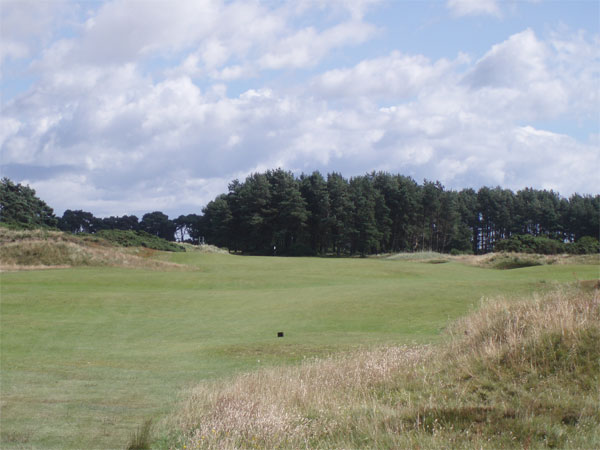
View from the start of the fairway on the par four seventh.
This hole is normally downwind, and plays to a double fairway with the sixth hole. If a driver is used then the sixth hole part of the fairway will run out and so the drive becomes much more tight.
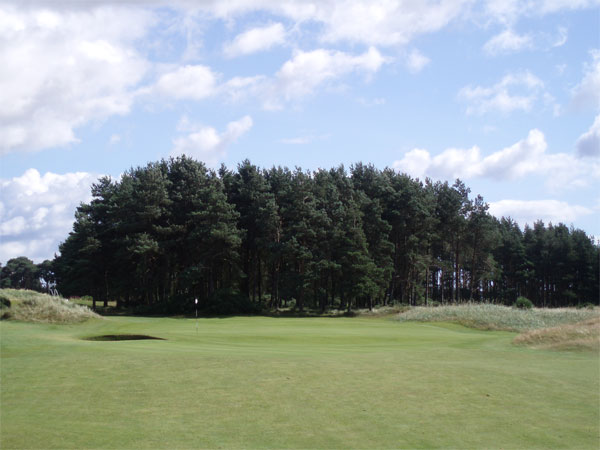
The green at the par four seventh.
The approach shot is tricky as the green is over the top of a hill and so you can only see the top half of the flag, yet the green has three tiers and so the length of your approach shot is key. The front and back tiers are too small to hold any pin positions and simply serve to make recovery shots difficult should you miss the centre tier.
Eighth hole “ par 4 “ 361 yards “ Hillocks: The tee shot here is totally blind, over bushes, to an angled and undulating narrow fairway that has OB to the right and bushes to the left. A sensible play is a long iron, but this leaves a second shot from most likely a side hill lie. Those who take the driver are rewarded by a larger landing area and a flat lie. The approach shot is also blind as the green is hidden between two hillocks. They should probably be called mountains as they are massive, although the locals have a more colourful name for them!
Ninth hole “ par 3 “ 180 yards – Monument: The second par three is played slightly downhill, typically with the wind from the left to a very undulating green with a large bunker at the front left. The whole green is on a hill and if you hit it through the green it is very hard to stop your second on the putting surface.
Tenth hole “ par 4 “ 436 yards “ Lucknowe

Tee shot on the par four tenth.
A classic links hole, this is a long dogleg right around the OB. From the tee you play to an angled fairway, with the main danger being a giant bunker in the right middle of the fairway. If you carry this you have a medium iron to the green. If you play left of it you’ll have a long iron in.
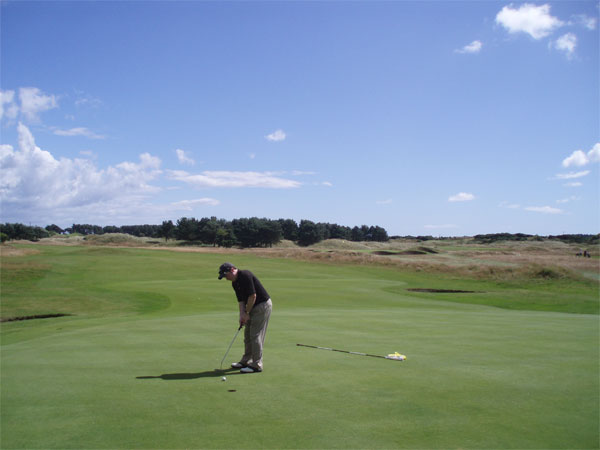
The author’s brother putts on the par four tenth green.
The second shot must carry another equally huge bunker, dead in the middle of the fairway, although at 100 yards from the green it is more of a line of sight distraction than a danger. The front half of the green slopes towards the fairway, while the back half is level. The tall trees behind the green shelter the approach from the wind, so short or long is a common mistake on this hole.
Eleventh hole “ par 3 “ 168 yards “ Sands:
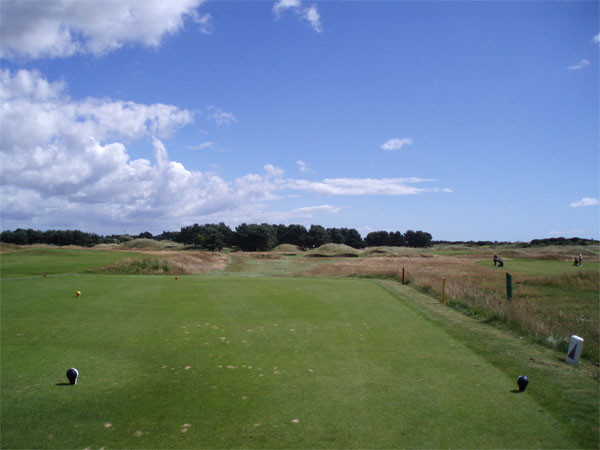
Tee shot on the par three eleventh.
A fairly straight away par three, surrounded by bunkers “ only a couple on the left of which actually come into play ¦ unless the pin is hidden on the right behind a tall and imposing bunker just short of the green. A short iron to the middle of this green and a par is guaranteed. However in the unusual case where this hole is into the wind you can find yourself hitting a long iron “ at which point all five greenside bunkers and a ditch to the right of the green become very relevant!
Twelfth hole “ par 4 “ 396 yards – Buddon Burn
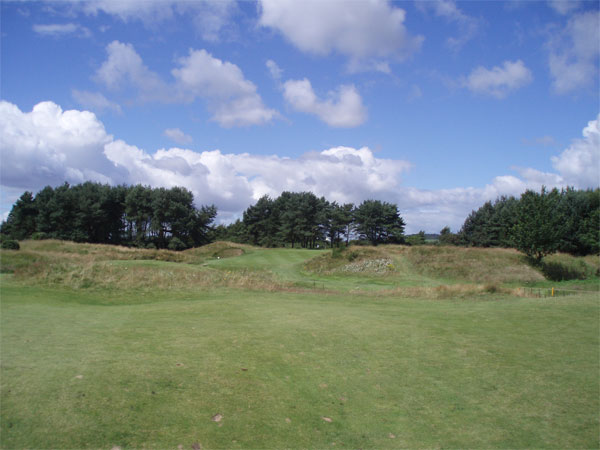
Approach shot from the end of the fairway on the par four twelfth.
The key from the tee is hitting this narrow fairway, which is covered in small undulations.

View from the far end of the course, behind the twelfth green. It is straight back to the clubhouse from here.
The second shot will therefore not normally be from a level lie, and has to carry the buddon burn, although this only really comes into play if you hit the rough from the tee and get greedy on the second shot. The green has a ridge through the middle of it and is uphill from the fairway, making distance judgment difficult. As with the tenth it has trees behind the green that can affect the wind, and if you miss the green the ball will run downhill into some nasty rough.
Thirteenth hole “ par 4 “ 396 yards “ Homeward
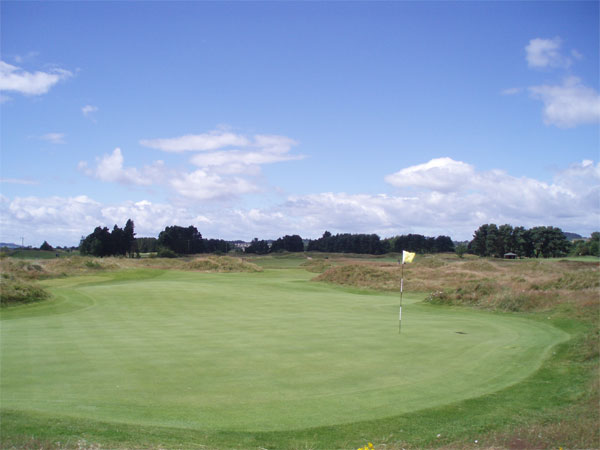
View from behind the par four thirteenth green.
The tee shot here, as you turn for home, is from a raised tee and is normally downwind. A three-wood or a long iron is needed to lay up short of a ditch that crosses the fairway, with the only danger being a hillock on the left middle of the fairway that balls seem to gravitate to! This hole is all about the second shot ¦ the green is one of the best on the course, sunken below the fairway and sloping from front right to back left. However there is quite a lot of open ground before the green that must be used downwind, and this is angled to kick balls to the right! Many a time a straight shot bounces so far right that it goes to the right of the hill to the right of the green and leaves a nightmare pitch. However, if you play too far left on the approach then it may hit a small hillock and get snagged there, short of the green. After ruining your perfect tee shot you then have a nice walk uphill to the fourteenth tee to reflect on what might have been.
Fourteenth hole “ par 5 “ 533 yards – Lucky Daddy
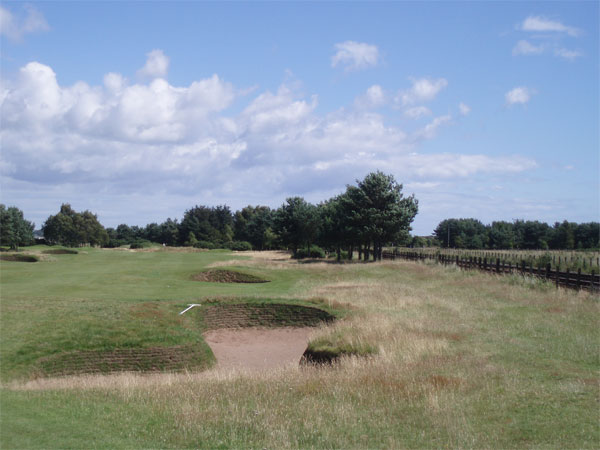
View from the right side of the par five fourteenth fairway, at around driving distance.
The second and last par five, you play from a raised tee to an undulating fairway that narrows with bushes left and bunkers right. Go right of the bunkers and you might hit the train as it roars by to Aberdeen. If you hit the fairway you have a difficult second in to a green hidden round to the left behind bushes and trees. The back half of the green is flat but the front half has a large swale right across it
Fifteenth hole “ par 3 “ 234 yards “ Dalhousie
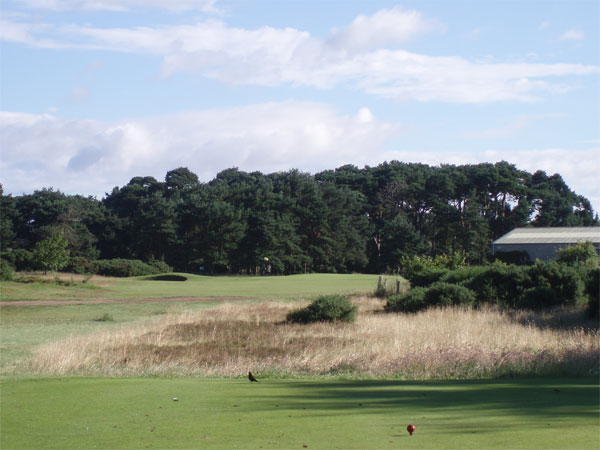
Tee shot on the long par three fifteenth.
The fourth and last par three is the hardest. 234 yards, with the wind behind and from the left to a domed green protected on the left by a string of bunkers. There is a ridge 20 yards short of the green to further confuse your distance perception. Must like the sixteenth at Carnoustie, a good play is sometimes to leave yourself twenty yards off the front and hope for a long two-putt.
Sixteenth hole “ par 4 “ 381 yards “ Cottage:
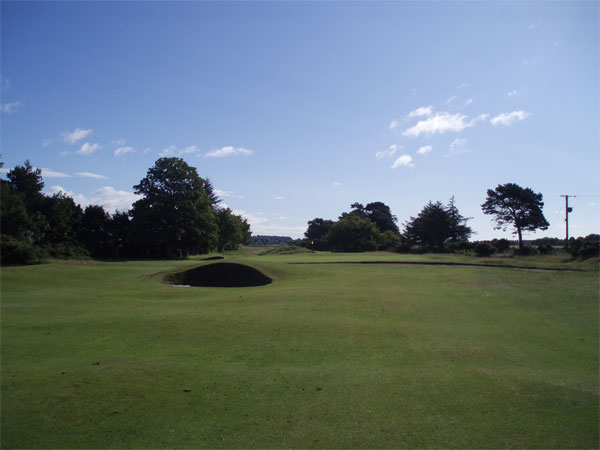
View from just short of the road on the par four sixteenth. It takes a very long drive to see this for your second shot.
As you move back to the flat part of the course, the sixteenth requires just a long iron off the tee, to set up a shot into a very tricky green. There is a central bunker that isn’t in play but which hides the green. Beyond that is a road that you must land just over if playing downwind, but just over the road is a ten feet wide dip that is about two feet deep and which can stop a ball dead fifteen yards short of the green. Assuming you make it over this, any ball left of centre may well be kicked into the front left greenside bunker, while any ball right of centre will hit flat ground and run onto the green. However while the back half of the green is flat, the front half slopes away from you, and at an angle so that balls run to the right. Hence to hit the middle of the green you need to play it as far left as you dare without it kicking left into the bunker!
Seventeenth hole “ par 4 “ 401 yards – Old Road
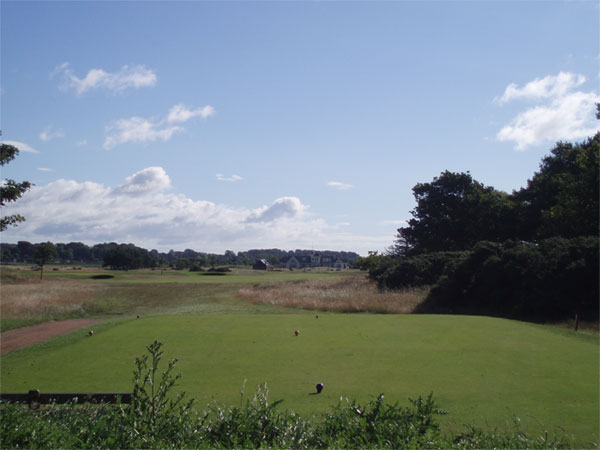
Tee shot on the par four seventeenth, where Ben Hogan practiced prior to the 1953 Open.
This is the hole where Ben Hogan practiced each morning prior to going to Carnoustie and playing practice rounds in the afternoons. He would stand in the middle of the fairway and hit iron after iron to his caddy who would be standing on the green to observe his accuracy.
This isn’t a hugely long hole, but the further down the fairway you go the narrower it gets. Go right and you’re dead with OB and then bushes, and a bunker is placed left just around the length of an ideal lay up. If you lay up short of this bunker you have a medium iron in to a large flat green.
Eighteenth hole “ par 4 “ 462 yards “ Calcutta

View from the left of the dogleg right par four eighteenth. A good tee shot will finish a little past the fairway bunker, but from the back tee just getting over the ridge is a good shot.
The closing hole can be extended to a huge 464 yards in competition, dog-leg right around the out of bounds to a green with OB left, right and long. From the forward tees you play over a small ridge to a fairway, keeping left of the ridge down the right and a large bunker at driving distance on the left of the fairway. From here you have a medium length shot in to a green surrounded by bunkers. From the back tees the tee shot is a lot more difficult. A good drive, even for the pros, will only get over the ridge a little, and any tee shot not hit perfectly may end up on or just short of the ridge.

Approach shot to the final green, Kummel is waiting for you in the clubhouse.
This creates a problem when your second shot is going to be about 230 yards! From the back tee the OB right is also a real danger, and yet if you go safely left off the tee you’re just making the hole even longer. The green is large and flat, but with the car park surrounding the green you’re guaranteed an audience as people wait and watch you putt before starting up their cars.
The End







